If we could collect and store all the energy we get from the Sun in one minute, we would have enough energy to power the Earth for a whole year!
But how can we collect this energy?
Plants and trees are pretty good at collecting this energy!
With the help of green chlorophyll, they use light energy to make food – they’re our solar powered food factories.
But how can we copy them?
Scientists and engineers are working on ways to do this and have developed photovoltaic cells, or PV cells for short, that can turn sunlight into electricity!
Originally developed to power satellites in space, PV cells are combined in solar panels and mounted on the roofs of buildings. They can also be used to power devices such as calculators and watches.
Sunlight lands on layers of special materials that are designed to create the electrons that are needed for electricity.
When these sunlit materials are connected to circuits, electricity flows. We can’t get very much power from PV cells yet, but the technology is improving all the time and although we’ll never be able to catch all the power from the Sun, we may be able to get enough to power some of our favourite devices.
We can also store the energy generated by solar cells in batteries to use at a later time.
Storing energy in batteries is not very efficient, but it is useful, so many solar-powered devices have a battery too that stores energy when it’s sunny, to use when it’s dark.
Key Facts
- Solar energy is plentiful, free and renewable.
- Solar panels do not produce any carbon dioxide emissions when converting solar power into electricity.
- Solar power can be used to create electricity in remote places where it might be very hard to get electricity through the National Grid.
But solar power also relies on us!
To fully benefit from any solar or insulation installation, we need to change our behaviour slightly.
For example, we need to insulate the property, turn down the thermostat and do the things that will make the most out of the energy solar power generates.
You can hear Curious Kate on:
- Fun Kids Radio
- iTunes
- or listen to the series below!
Curious Kate is supported by British Gas Generation Green.
Add a comment


